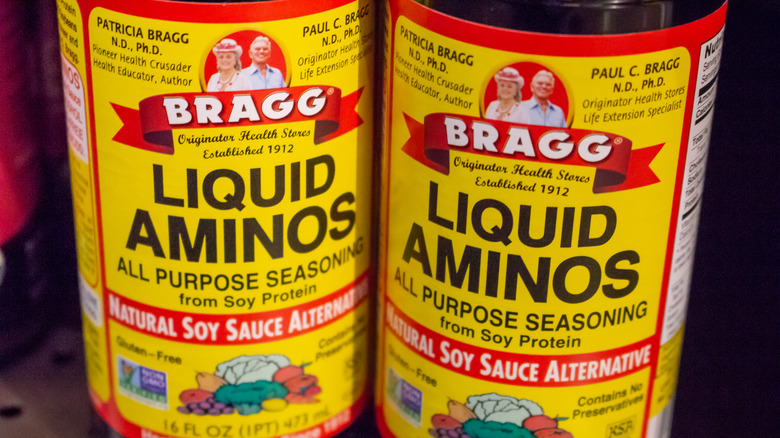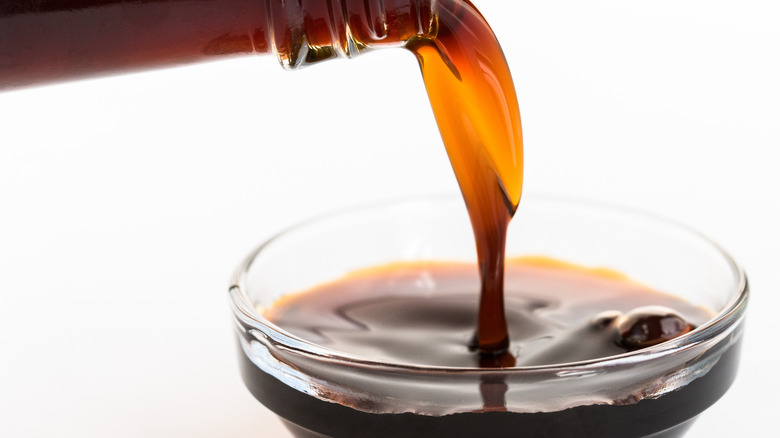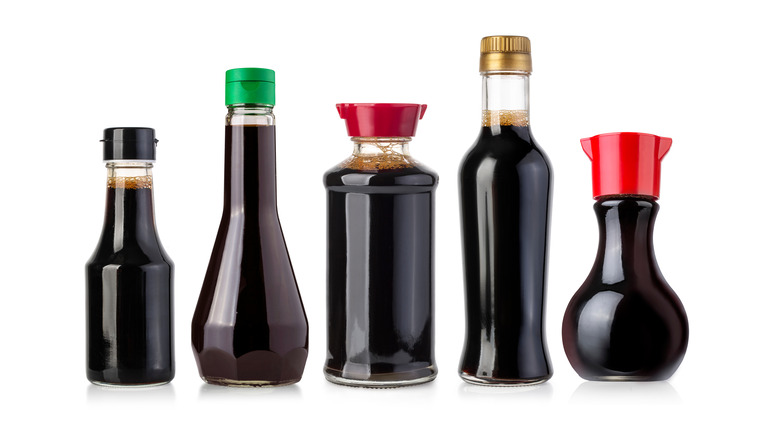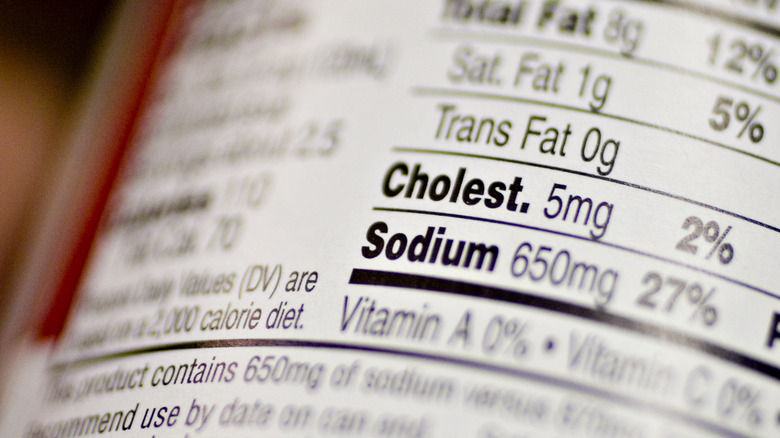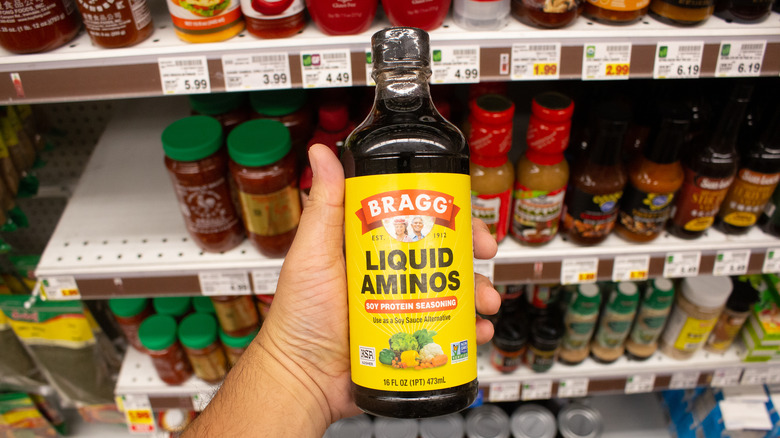Liquid Aminos Vs Soy Sauce: What's The Difference?
When it comes to seasonings and condiments, many of us have our favorites. Adding a few dashes of spice, salt, or sugar to our plates is an easy way to take an otherwise bland meal to the next level.
Looking at basic biology, the human tongue is equipped to detect a wide variety of flavors, but scientists have simplified the palate into five taste categories — sweet, sour, salty, bitter and savory/umami (via Annals of Saudi Medicine). Foods that appeal strongly to these tastes are likely to attract or deter us depending on our preferences, and when it comes to seasoning with salty flavor, soy sauce is a condiment that can excite your tastebuds. The useful sauce is a staple in many refrigerators.
But, it does have a lesser-known competitor. Liquid aminos looks and tastes very similar to soy sauce. In fact, the two are closely related but not completely interchangeable due to slight differences in ingredients and sodium content.
What are liquid aminos?
Liquid aminos is essentially concentrated amino acids in a consumable liquid form. If you're familiar with soy sauce (which we'll get into below), liquid aminos looks and tastes similar. However, there are a few key differences.
The last time you heard "amino acids" might have been in high school biology, but we're going to revisit the term. To fully grasp what liquid aminos is, it's important to first understand where it comes from. Amino acids are the essential building blocks of protein, and play vital roles in muscle-building, cell signaling, immunity, and more (via Healthline). The body utilizes two kinds of amino acids: non-essential, which can be created from within the body itself, and essential, which can only be obtained through diet. Liquid aminos, after they're processed, is thought to have both.
Like soy sauce, liquid aminos is made from soybeans. According to ChefSteps, the process starts by treating soybeans with an acidic chemical solution, which breaks down the soy proteins, freeing amino acids. Then, water and sodium bicarbonate are added to neutralize the mix and create sodium chloride, which gives the dark liquid its salty taste.
What is soy sauce?
As its name indicates, soy sauce is derived primarily from soybeans combined with a few extra additives before it's bottled and stored in your fridge.
The production process begins with harvested soybeans. They're soaked in water for several hours before they undergo a steaming process, reports WebMD. Whilst steaming, the other ingredients are prepared. Wheat is roasted and ground into flour before being added to the soybeans, and certain fungal spores like A. tamarii, Aspergillus oryzae, and A. sojae are added and left in the mix for about three days.
The next step is fermentation. Historically used as a way to preserve food, fermentation, or the controlled growth of beneficial microbes, is used in a variety of food and beverages from kombucha and alcohol to sauerkraut and more (via Nutrients). According to Science Direct, the growth of friendly bacteria helps stabilize perishable items but is now used more frequently to achieve desirable taste and qualities in food and drink. For soy sauce, fermentation involves adding brine and letting the liquids ferment anywhere from one month to four years before being filtered, pasteurized, and bottled.
The final product tastes predominantly salty and is savory overall, with hints of sweetness and a barely-detectable bitterness. A lot of flavor is concentrated into a small amount of soy sauce, making a few dashes of the dark brown, almost black liquid popular as a takeout topping, marinade, or glaze.
What are the differences between the two?
Though they may be similar in their taste and appearance, soy sauce and liquid aminos have several differences that start with the ingredients. Yes, both come from soybeans — though Healthline reports that liquid aminos can sometimes be derived from coconut sap, too — but from there the production processes go their own ways.
Remember that in the traditional soy sauce production process, the soybeans are mixed with wheat, salt, and several other ingredients before embarking on the fermenting process. In liquid aminos, there isn't any fermentation. There's no wheat either, and there is no alcohol, which is created during fermentation in soy sauces, according to Kikkoman. Instead of fermenting, the soybeans are dressed with chemical solutions and water. This makes liquid aminos naturally gluten-free and suitable for a variety of diets (via My Recipes). Further, soy sauce often contains sodium benzoate, a type of preservative that isn't found in liquid aminos, Healthline reports.
Nutritional differences between soy sauce and liquid aminos
The nutritional differences between soy sauce and liquid aminos might not be discerned with a simple taste test, but they're there. The difference shows itself mostly in the amount of sodium in each product.
Both taste salty, first and foremost, which is why they are both popular seasoning choices for all sorts of foods. While neither condiment skimps on the sodium, soy sauce has more. You'll find about 960 milligrams of sodium per tablespoon of Kikkoman Soy Sauce (via Kikkoman), and 310 milligrams per teaspoon (930 milligrams per tablespoon) of Bragg Liquid Aminos (via Bragg). Keep in mind that, according to the FDA, your daily recommended value of sodium is about 2,300 milligrams. While there are options for low-sodium soy sauce, if you're trying to cut down your sodium intake it could be best to note the slightly lower content in the liquid aminos when reaching for a sauce to dip your California roll in.
In terms of other nutritional content, both are relatively low in calories with about 10 per tablespoon in soy sauce and 5 per teaspoon in liquid aminos. Both condiments have low amounts of protein (1 gram per teaspoon of liquid aminos and 2 grams per tablespoon of soy sauce) and zero fat.
How to buy liquid aminos
If you're interested in trying out liquid aminos for yourself, you'll be happy to know that a trip to the grocery store is all you need to pencil into your schedule. A popular and widespread brand of liquid aminos you can find in most grocery stores is Bragg Liquid Aminos. Often you'll be able to locate in the following areas, according to The Spruce Eats: the spices and seasonings aisle, the health food aisle, or lined up next to the arrangement of soy sauces or vinegar.
One thing to keep in mind, aside from health considerations, is the price. According to Healthline, liquid aminos are typically more expensive and can cost up to three times as much as regular soy sauce. Still, the ingredient can be found in most chain grocery retailers, so you should be able to get your hands on it if you want to.

